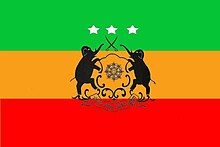चकमा लोग
𑄌𑄋𑄴𑄟𑄳𑄦 | |
|---|---|
 | |
 चकमा महिला पारंपरिक पहनावा में। | |
| कुल जनसंख्या | |
| ≈ 800,000 (2011–2022) | |
| विशेष निवासक्षेत्र | |
| बांग्लादेश,[1] भारत[1] और म्यांमार | |
| 483,299 (2022)[2] | |
| 228,281 (2011)[3] | |
| | 92,850 |
| | 84,269 |
| | 47,073 |
| | 3,166 |
| | 175 |
| | 159 |
| | 156 |
| 80,000[] | |
| भाषाएँ | |
| चकमा | |
| धर्म | |
| सम्बन्धित सजातीय समूह | |
| डैंगनेट, तांचांग्या, राखाइन, बमर | |
चाकमा (Chakma) बांग्लादेश के चट्टग्राम पहाड़ी क्षेत्र का सबसे बड़ा समुदाय है। यह चाकमा भाषा बोलते हैं जो एक हिन्द-आर्य भाषा है और हिन्दू व थेरवाद बौद्ध धर्मों के अनुयायी होते हैं। यह भारत के मिज़ोरम राज्य और बर्मा के रखाइन राज्य के कुछ क्षेत्रों में भी निवास करते हैं। आनुवांशिक दृष्टि से चाकमा लोगों का बर्मा व तिब्बत की मूल जातियों से सम्बन्ध है।[4][5][6][7][8]

उत्पत्ति
आधुनिक भाषाविद्या के अनुसार, "चकमा" शब्द का उत्पत्ति के संदर्भ में दो शब्दो से बना माना जाता है: "ट्सक" और "मा". इस संदर्भ में, "ट्सक" माना जाता है जो "शक्य" जाति से संबंधित है, और "मा" तिब्बती-बर्मी भाषाओं में "आदमी" का संकेत करता है।[9] चकमा लिपि में ब्राह्मी लिपि की समानताएँ होने से यह सुझाव दिया जाता है कि चकमा लोग शाक्य वंश से उत्पन्न हो सकते हैं।[10]
इतिहास
चक्मा जनजाति के पवित्र ग्रंथ बीजक में यह उल्लेख है कि उनके पूर्वज शाक्य राज्य से अरकान (अब म्यांमार के राखाइन राज्य) में प्रवास कर आए थे।[11] उनका मानना है कि वे बुद्ध के साक्य जाति के अंश हैं, जो हिमालयी जनजातियों में से एक है।[12]
इन्हें भी देखें
सन्दर्भ
- ↑ अ आ Library of Congress Subject Headings. I (13th संस्करण). Cataloging Distribution Service, Library of Congress. 1990. पृ॰ 709. मूल से 21 September 2023 को पुरालेखित. अभिगमन तिथि 23 December 2016.
- ↑ "Table 1.4 Ethnic Population by Group and Sex" (PDF). Bangladesh Bureau of Statistics. 2021. पृ॰ 33. मूल से 15 March 2023 को पुरालेखित (PDF). अभिगमन तिथि 22 November 2022.
- ↑ "Table C-16 Population by Mother Tongue: India". www.censusindia.gov.in. Registrar General and Census Commissioner of India. मूल से 4 June 2022 को पुरालेखित. अभिगमन तिथि 15 August 2022. 'चकमा' देखें। चकमा राज्यों में नहीं दर्ज है, इसलिए उनकी जनसंख्या का अनुमान लगाने के लिए भाषा सबसे अच्छा माध्यम है।
- ↑ A-E. Cataloging Distribution Service, Library of Congress. 1990. पपृ॰ 709–.
- ↑ Library of Congress Subject Headings. Library of Congress. 1992. पपृ॰ 769–.
- ↑ "Chakma (people)". Encyclopædia Britannica. मूल से 26 जून 2019 को पुरालेखित. अभिगमन तिथि 19 अप्रैल 2019.
The majority of Chakmas—numbering about 300,000—remained there [in the Chittagong Hills] into the 21st century.
If about 300,000 was a majority, then the total population was no more than about 600,000 as of 2001. - ↑ Bhuiyan, Muhammad Masudur Rahman (2012). "Noakhali Sadar Upazila". प्रकाशित Islam, Sirajul; Jamal, Ahmed A. (संपा॰). Banglapedia: National Encyclopedia of Bangladesh (Second संस्करण). Asiatic Society of Bangladesh.
The tribal population [of Bangladesh] in 2001 was 1.4 million, which was about 1.13% of the total population. The figure was 1.2 million in 1991, of which chakma population was 252,258
If the Chakma population grew at the same rate as the tribal population overall, their 2001 population in Bangladesh would have been about 288,300. - ↑ "Statistical Profile of Scheduled Tribes in India 2013" (PDF). Ministry of Tribal Affairs. Government of India. मूल (PDF) से 4 दिसंबर 2018 को पुरालेखित. अभिगमन तिथि 19 अप्रैल 2019.
Mizoram: 19,554 ... Tripura: 18,014 ... Meghalaya: 44 ... Assam: 430 ... West Bengal: 211
Total population in India: 38,253. - ↑ Pannalal Majumdar (2013). The Chakmas Of Tripura, 2nd Edition. Tribal Research & Cultural Institute, Govt. of Tripura. पपृ॰ 38–39.
- ↑ Sumana Bhattacharyya (2004). A linguistic study of Chakma. University Of Calcutta. पृ॰ 1.
The Chakma script shows similarities to Brahmi script, indicating cultural links. There's a theory suggesting Chakmas may descend from the Shakya lineage of ancient India.
- ↑ Ranjan, Chitta (2022). The Chakmas In Southeast Asia. H. S. R. A Publications. पृ॰ 112. आई॰ऍस॰बी॰ऍन॰ 978-93-5506-169-0.
- ↑ Pannalal Majumdar (2013). The Chakmas Of Tripura, 2nd Edition. Tribal Research & Cultural Institute, Govt. of Tripura. पृ॰ 38.
Bijak of the Chakmas we can easily take into our considerations that the Chakmas went to Burma from India in far ancient times. As the Chakmas regard them as the desendents from the shakya clan.